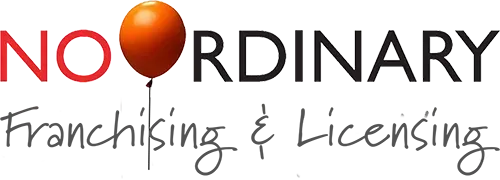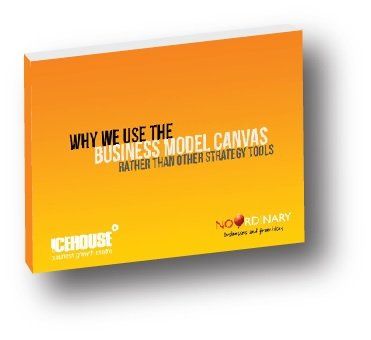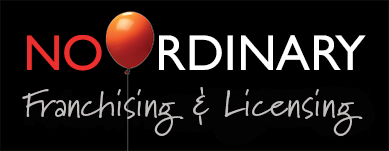THERE ARE ONLY TWO WAYS TO FUTUREPROOF YOUR BUSINESS. EVOLVE. OR DIE.
Sooner or later, all businesses — even yours — run out of ooompf. Then the choices are simple — will you spiral downward into oblivion or jump on to the next growth curve?
Here are the cold, hard facts.
Once a company runs up against a major stall in its growth, it has less than a 10% chance of ever fully recovering, according to Matthew S. Olson and Derek van Bever in their book Stall Points.
It happened to Levi Strauss. The year was 1996 — nearly 150 years after the company began in 1853. The company had just achieved record sales, breaking through $7 billion for the first time in its history.

Year-end sales for 2000 were $4.6 billion — down more than one-third from four years before. The company’s market share plummeted even more — from 31% in 1990 to 14% by 2000. Since then, Levi’s has tried and tried to reinvent itself — but although the company has recovered somewhat, it has yet to return to its former glory.
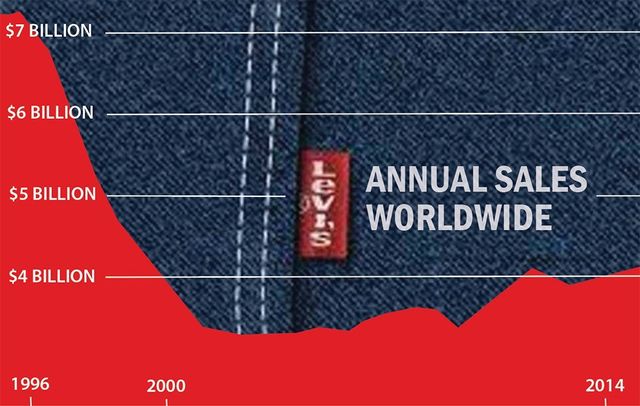
Here’s the pattern from Stall Points’ analysis of Fortune 100 and Global 100 companies that experienced stalls between 1955 and 2006 – after record growth, sales don’t just drop off, they drop “like a stone”.

Down but not quite out.
“Like Levi Strauss, most organsations actually accelerate into a stall,” says Stall Points. “When the momentum is lost, it’s as if the props have been knocked out from under their corporate strategy.”
Surprisingly, the reason had to less to do with external factors than factors within management’s control.
So what did the few companies that Stall Points
found had successfully reinvented and continued to reinvent themselves have in common?
They fixed themselves before they got broken.
The chart below from the article ‘Throw Your Life a Curve Ball’ by Whitney Johnson in the Harvard Business Review
shows how businesses as well as careers work in waves, or ‘S Curves’. An S Curve describes how business performance tends to slow down after an initial growth phase. It’s called stalling.
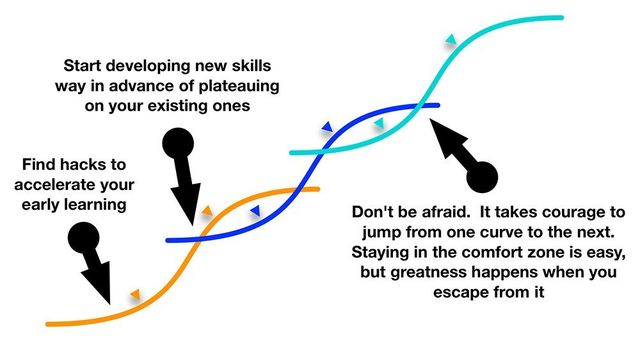
Most businesses, including industry leaders, fail to recognise when their business model is about to stall. But high performers are different. They jump off the old S Curve and on to a new one before their existing businesses start to stall.
How do they do that when, as Stall Points
found, stalls often occur right after periods of record sales?
“They tend to broaden their focus beyond the financial S curve,” say the authors, “and manage to three much shorter but vitally important hidden S curves—tracking the basis of competition in their industry, renewing their capabilities, and nurturing a ready supply of talent. In essence, they turn conventional wisdom on its head and learn to focus on fixing what doesn’t yet appear to be broken.”
What causes stalling?
There’s no shortage of explanations—from deviating from the core business to failing to respond to competition and changing tastes and fashions.
One of the causes of stalling is, of course, disruption. Although the word means a disturbance or interruption in an industry, it’s much more than that, according to Horace Dediu in his article ‘What Is Disruption and How Can It Be Harnessed?’
“The nominal definition I work with is that disruption is the ‘transfer of wealth in an industry from dominant incumbents to disadvantaged entrants’,” he says.
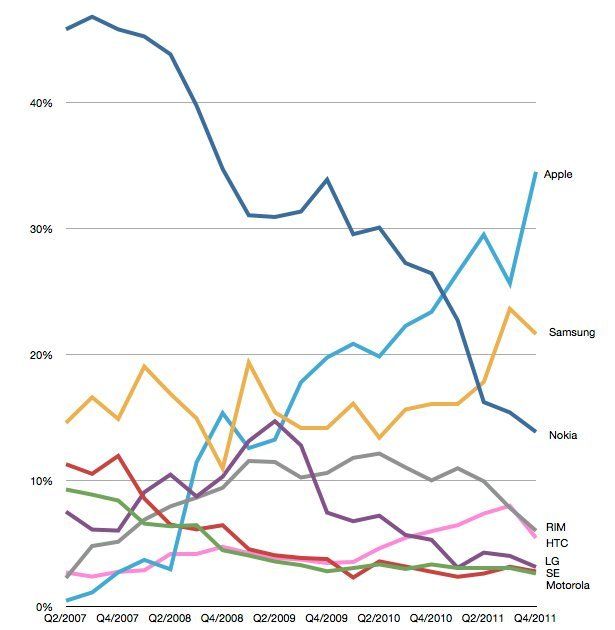
The graph above from ‘What Is Disruption and How Can It Be Harnessed?’ shows how disruption affected the performance of the major players in the mobile market from 2007 to 2011. Nokia went from a seemingly unbeatable position to a complete stall over this period.
“Disruptive innovations are like missiles launched at your business.”
So says ‘Mr Disruption’, Clayton M. Christensen, the originator of the term ‘disruption’ in its modern business sense, and co-author of the article Surviving Disruption
with Maxwell Wessel.
In the two decades since his breakthrough book The Innovator’s Dilemma
came out, Christensen has identified plenty of missiles that have thrown established businesses into a stall – the rise of Netflix causing the decline of Blockbuster, iTunes shaking up the music store industry, digital photography throwing Kodak into a spin, and many more.
“And all along we’ve prescribed a single response to ensure that when the dust settles, you’ll still have a viable business:
“Develop a disruption of your own before it’s too late to reap the rewards of participation in new, high-growth markets.”
Surviving Disruption
also puts forward a systematic way to determine whether a disruption missile is likely to hit or miss your business:
- Identify the strengths of your disrupter’s business model
- Identify your own relative advantages
- Evaluate the conditions that would help or hinder the disrupter from co-opting your current advantages in the future
Business stalls and disruption are a fact of life in today’s fast-changing commercial environment, but many business owners feel unequipped or under-resourced to respond strategically to the forces of change.
How can you avoid stalls and disruption in your business?
We at No Ordinary Businesses and Franchises have launched a new service designed to help business owners and franchisors to evaluate the likely impact of change on their businesses, develop strategic responses, and identify new growth ‘S Curves’ and disruptions of their own.
We've called the service ‘The Disruptor’ and it is available now – simply contact us for a free initial consultation in strictest confidence.
Articles referred to in this article:
When Growth Stalls
By Matthew S. Olson, Derek van Bever and Seth Verry
Harvard Business Review, March 2008
Reinvent Your Business Before It’s Too Late
by Paul Nunes and Tim Breene
Harvard Business Review, January-February 2011
Surviving Disruption
by Maxwell Wessel and Clayton M. Christensen
Harvard Business Review, December 2012
I’m Robin La Pere, no ordinary business, marketing and franchise consultant. As you read my article at left, you’ll probably wonder why there’s a picture in the banner of Charles Darwin, one of the developers of the Theory of Evolution, when the case study in the article deals with Levi Strauss & Co, the iconic brand that’s been sewn on to jeans since 1873.
I’m pretty sure Darwin never wore Levi’s, but he did have a few things to say about how living things — including businesses — need to keep adapting to their environment if they’re to survive. Levi Strauss & Co managed to do that for more than 120 years, becoming a youth symbol and ultimately peaking at sales of $7 billion in 1996. But a surge of cooler competitors walked away with half of Levi’s market share during the 90s and the company’s leadership had no idea what to do to stop them.
This, then, is an article about how businesses must keep evolving, keep reinventing themselves if they’re to keep one step ahead of disruption and prevent themselves from stalling.
Need to futureproof your business?
I offer these services to help you manage disruption, prevent stalling and promote innovation in your business:
- Threat and opportunity evaluation
- Business model generation
- Strategy planning
- Key business driver analysis and development
- Conference and seminar presentations
- Innovation workshop facilitation
- Business improvement
- Business re-engineering
- ‘The Disruptor’ Programme (see below)

Are you facing new or greater competition? Is your industry being disrupted? Is your business growth in danger of stalling?
The best way to predict the future is to create the future. In today’s fast-changing world, it’s disrupt or be disrupted. The good news is that small to medium sized businesses can be more innovative and agile than large corporations. The Disruptor Programme has been developed specifically to help SME leaders to:
- empower them with the thinking and practical skills to face change and lead a more agile and innovative business
- gain insights in how their customers see value and where opportunities exist to take advantage of this
- examine the company’s competencies and culture in order to identify opportunities to improve and innovate
To arrange a free personal Initial Consultation with me on how The Disruptor Programme can help you to futureproof your company, contact me now on +64 9 360 6063 or Skype Noordinary1262 or send me your email address and I will get back to you within 24 hours.
